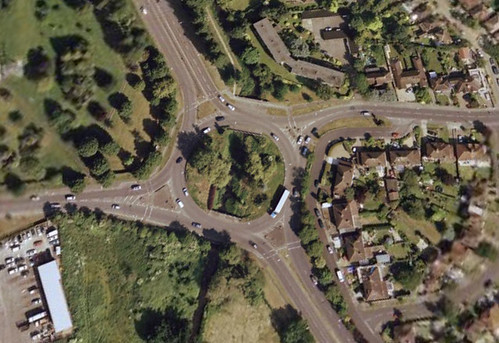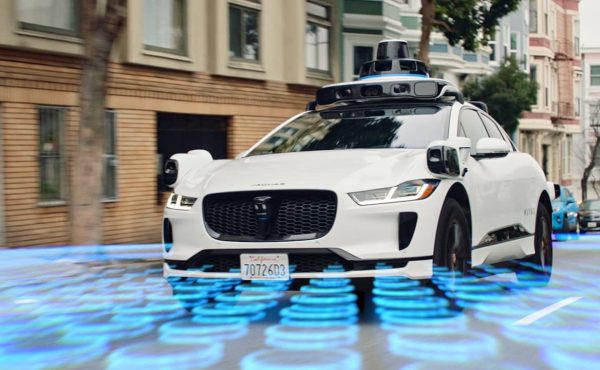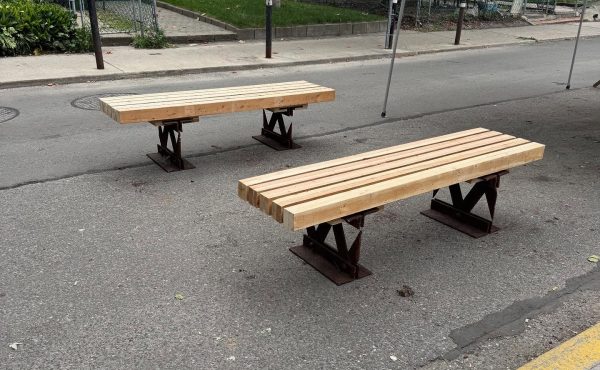
Last week, I did a series of posts regarding cycling and traffic calming in Vancouver. One of my observations focused on the roundabouts installed at smaller intersections, something that Toronto is in short supply of. To give a historical perspective on the modern roundabout, and the current spike in North American roundabouts, is an article from today’s International Herald Tribune. I’d love to hear what Spacing Wire readers think of roundabouts.
Modern roundabouts have been popular in Britain since the 1950s and were adopted by other European countries during the 1980s and 1990s. More recently, they’ve been introduced, initially on a trial basis, to the United States and Canada. Those trials have proved so successful, not least in dispelling drivers’ fears of the strange circular junctions – remember when “The Simpsons” visited Britain only to find themselves driving around and around one? – that many more roundabouts are now being built.
“When construction started, there was a quite an outpouring of concern,” said Tom Adriance, highway superintendent of Malta, a town in upstate New York, where five roundabouts were recently completed and another seven are planned. “It was something new, and people were nervous. But as they’ve gotten used to the roundabouts, they’ve realized the benefits. The traffic moves quicker and flows pretty freely; very rarely is there any type of stacking or backup. Who wants to sit at a red light for two or three minutes?”
The success of the modern roundabout’s design is rooted partly in its structure and partly in its ability to modify motorists’ behavior by encouraging them to drive more slowly and considerately. It dates from the early 1900s, when William Phelps Eno designed Columbus Circle in New York as a “gyratory traffic circle” where vehicles drove around a central island. Across the Atlantic, his archrival, Eugà¨ne Hénard, was developing a similar idea around the Arc de Triomphe in Paris.
Other traffic circles followed, but there was no consistency in deciding how drivers should use them. There were no rules in Britain, and in the United States some cities gave priority to north-south traffic and others to approaching vehicles. The confusion didn’t matter when the roads were empty, but as traffic increased from the 1950s onwards, the circles became congested.
This problem was addressed in Britain by the invention of the modern roundabout with a smaller island and wider entrances. Critically, approaching drivers were obliged to give way to vehicles already inside, prompting them to slow down before entry. The result was less congestion and fewer accidents, especially when compared with traffic signals, where drivers often accelerated to race through and avoid red lights.
photo by Alan Saunders




26 comments
I’m a big fan of the traffic circle. Here is one of my favourites in Mississauga: http://tinyurl.com/2gxueo Complete with a nice rarely used park in the middle.
You should make a list of the top 10 GTA roundabouts or something. 🙂
In GB and Malta I loved driving through roundabouts (especially Malta where the rules are more….flexible) but as a pedestrian they are as walkable as freeway interchanges. They gave urban areas a decidedly unurban feel.
While I personally like them, I have almost had accidents using them because nobody can pay attention to the Yield signs that surround them.
To further complicate this, in some states like New York, the car in the roundabout has the right of way, while in Massachusetts, the car entering the roundabout has the right of way.
Sites for roundabouts need to be chosen with care – they are good for small junctions but eventually as traffic increases they hit a size where they are three lanes across and the accident rate spirals. Once you are at a point where you consider signalising a roundabout, you probably should be building a flyover. Sadly Ireland (Dublin’s M50/N7 junction, Cork’s “magic roundabout” and Sarsfield Road/Ring Road roundabout) learned that one the hard way.
Waterloo Region has built several over the past year or two – the new roundabouts have really helped in a couple of spots where one would wait forever to make a left turn, especially at the Hwy 85/Cty Rd 17 junction at St. Jacobs.
How do they fare for cycleability?
The photo above looks like it would not be bad for cyclists and pedestrians, but what if there are two or more lanes?
I think it would be a great idea if it increased efficiency, so long as it did not make walking and biking unpleasant. Do they act as traffic calming, or do motorists see them as a way to drive faster?
Mark> Yes, the little neighbourhood ones are great — one lane each way — they get rid of stop signs, and keep things flowing. But when they grow larger than a standard neighbourhood intersection, I found they are a pain to walk around. I like to walk, yet these seemed designed to keep me from getting to where I wanted to be (on foot). Flyovers are good/bad — when does a flyover become a Gardiner Expressway type structure?
Ben> If the rules are followed, and the cyclist is confident (in their ability, and their faith that motorists will obey rules too) they keep things flowing nicely, and I’d welcome them (if i didn’t have to walk around them).
I experienced roundabouts a lot as a pedestrian when I lived in England, and I think there are pedestrian issues that need to be addressed. Usually the small local roundabouts were fine (in fact, the effect is similar to a four-way stop). But once you get bigger ones with heavier traffic volume, it can be a real problem. First, of course, pedestrians have to walk a noticeably longer distance to get around them. But also, the cars don’t really want to have to wait for pedestrians because they might miss an opening, so they can push a little more aggressively.
The benefit, on the other hand, is that all cars end up moving more slowly, which makes for a more pleasant environment.
One of the reasons they are popular in England is that is doesn’t have a grid system – there are often cases where lots of roads meet at irregular angles. They definitely make sense in those situations. But it’s important to think of the impact on all travellers – walkers and cyclists as well as cars – and to make sure their experience is improved, too, if we are thinking about introducing a relatively new concept like this.
The only major one I experienced was the one at the Arche de Triomphe. The funny thing is that because of the roundabout, the only way to access the Arche is by underground tunnel. There are signs everywhere telling you not to cross the roundabout. The cars moved fast and it was a wide road, so you’d really be taking a risk in do so.
However, if I recall correctly, there were stop signs and pedestrian signals at the entrances to the roundabout, so crossing the roads leading into it wasn’t all that bad.
Looking at the photo above makes me sick to think of riding my bike through it. I’m rather brave when riding my bike, but unless the bike lane was very distinctive (painted another colour perhaps) I can just imagine the close attention need by both drivers and cyclist at each traffic merge, let alone if a cyclist wanted to make a left hand turn. Changing lanes while in a curve is deadly for cyclists, I can only assume.
I felt quite vulnerable at some of Vancouver’s small roundabouts.
Shawn – the flyover ones are a combo of grade separation and roundabout which is most useful when there is disproportionate traffic in one direction. If you’ve already built the roundabout it’s about the only way you can keep the junction open whereas with a generic flyover you’d have to shut the whole thing down. The combo is handy too when you have approach issues where you want to slow the traffic rather than have it tear down a ramp and into a speed-limited tunnel (as in the N25/N8 junction in Cork)
Matt – if in doubt stay in the outside lane. Nothing illegal about it. Rumble strips on the approaches might help deter simply blasting through the Yield.
^Yeah — in the big roundabouts, like the one above, it would be like when you’re riding along one of the suburban arterials on your bike, and a freeway-like entry lane comes on on off (like Dufferin heading north under the 401) — you end up in the middle of 2 or 3 lanes, and it’s fast 60khm+ traffic. There is no curb lane to take refuge in, since the curb becomes another lane.
At the neighbourhood level, these would take the illegality out of all the rolling stops we do when it’s obvious there are no cars, pedestrians or bikes anywhere nearby.
I agree with Dylan and Matt and others above that roundabouts are not pedestrian-friendly. I have negotiated many roundabouts while (perhaps foolishly) walking in cities and villages in England, and unless there are extra islands between the lanes leading up to and exiting the roundabout where one can wait for cars *exiting* the roundabout, crossing the streets is quite harrowing. True, cars may slow down to enter the roundabout, but they accelerate while leaving, ‘yee-ha, I am out of the roundabout!’ Perhaps they may be best suited to suburban situations here where there is not a lot of pedestrian traffic. But in an urban environment with increased traffic volume and lots of pedestrians, I would be against them.
I’ve been musing about the idea of 4-way yields (as opposed to 4-way stops). Interestingly, at most smaller intersections in Germany, there are no stop signs, rather one slows down at an intersection and yields to traffic oncoming from the right, if present. It seems like this might offer significant benefits w.r.t. greenhouse gas reduction. Most 4-way stops in Toronto are de facto 4-way yields as drivers tend to do rolling stops anyway.
I agree with Nick, roundabouts are quite hostile to pedestrians.
I’m in Waterloo Region (mentioned in the article), but haven’t had the opportunity to check out that many roundabouts (none near me). One plus is that all the ones they are building have that ‘centre island’ for pedestrians, so you only need to dodge traffic from one direction at a time. The tricky part is the side with traffic departing the circle, as you can’t always be sure exactly who’s exiting. I do alright, but thinking of the effect on the disabled, elderly, etc. does give me pause.
I still find the concept of four-way stops somewhat amusing. That just wouldn’t work in Scotland; no one would give way.
Cycling a roundabout is tricky, especially if you don’t know the lanes and exits. Even the dreaded left turn (that’s the equivalent of a right) can be executed with aplomb with a little practice.
Roundabouts aren’t particularly pedestrian unfriendly. If you’re used to having ped right of way at junctions (which you technically do in the UK, just not in practice), it’s a bit of a shock. Big roundabouts have islands in the junctions. Really big ones have crossings or underpasses through the middle.
At least no-one’s proposing a contraflow roundabout like the famous Plough interchange in Hemel Hempstead: http://en.wikipedia.org/wiki/Magic_Roundabout_(Hemel_Hempstead)
Did you know there were plans to have a roundabout here in Toronto. When University Ave extended south to Front, once upion a time, there were plans to build a roundabout just south of queen street on the new section of University. Imagine what that area would look like if the plans ever fell through.
Round abouts in the West End of Vancouver are
terrifying! The intersections are too small and
no one seems to know for certain who has the right of way so many just race into them. The city lets
citizens garden these islands and what often results is a tall screen of green that obliterates all chance of knowing what is ahead on the other side. Nah–circles allowing two-lane entry work, but
not wee intersections where pedestrians play ‘You Bet Your Life’.
Alden> Yep — Vimy Circle
^re. scruss’s comment “Roundabouts aren’t particularly pedestrian unfriendly. If you’re used to having ped right of way at junctions (which you technically do in the UK, just not in practice), it’s a bit of a shock. Big roundabouts have islands in the junctions. Really big ones have crossings or underpasses through the middle.”
Great (ignoring the “just not in practice” part), so pedestrians are forced into some dank and filthy tunnel under the roundabout in the name of traffic efficiency. As an aside, these kind of pedestrian tunnels to smooth traffic flow were all the rage in Soviet block cities (I have seen them in Warsaw and Yerevan). And we know how the Soviets loved to consult with the public…
Perhaps the whole roundabout discussion is a red herring for more people being able to drive their cars. There is something to be said (apart from the smog aspect) for the fact that congestion is an effective way to limit automobile traffic growth. The focus should be on transit and bike lanes. While the air we breath is a public space issue, I think we need to balance this with the public space issue of the type of type of traffic – pedestrian, cycle, car, transit – using the our thoroughfares.
As another aside, the Economist has had a couple of articles on the ‘boom’ in roundabouts in the US (http://www.economist.com/world/na/displaystory.cfm?story_id=9621685). Again, in a suburban setting maybe they make sense.
My experience is that without traffic lights, roundabouts are very difficult and dangerous for pedestrians to cross, since cars do not tend to yield to pedestrians when entering the roundabout.
Remember when the QEW / Centennial Parkway interchange in Stoney Creek was a roundabout?
http://www.thekingshighway.ca/PHOTOS/qew-245_lg.jpg
“The Stoney Creek Traffic Circle was once one of the most prominent features on the QEW. The gigantic traffic circle was completed in 1938, and provided access between the QEW and Hwy 20 (Centennial Parkway). The Stoney Creek Traffic Circle was removed in the mid-1970s, and replaced by a freeway grade separation and interchange. The railway line running across the diameter of the circle was removed at the same time. ”
The traffic circle was the highlight of the drive to Niagara Falls, just after the Burlington Skyway. I think the access off the north side of the traffic circle was to Beach Boulevard???
Mike> We’ve got an article in the next Spacing about how the QEW was a grand highway when it was built, and slowly became the utilitarian thing it is today.
Didn’t know about the roundabout — but the KingsHighway site is yet another great niche infrastructure fetish corner of the internet.
For what it’s worth, the City of Edmonton built several roundabouts (a/k/a traffic circles) during its post-war housing boom, in large part because many of the employees in the transportation department were from the UK. The roundabouts are all two lanes wide, and those outside the circle yield to those within the circle. Since the 1980s, these features have been slowly replaced by more traditional intersections, but several still exist.
I take the point of some of the commenters above about pedestrian-unfriendliness, and, as an active cyclist, I have always found ways to avoid (or, if push comes to shove, dismount and become a pedestrian). However, there are positives from a traffic safety initiative, as motorists travel more slowly through a circle and never “gun it” to make that stale green as at an intersection. Also, even though the pedestrian path is a bit more of a hike, each pedestrian crossing is two lanes long and cars are already stopping. Contrast this with crossing six lanes of traffic with left- and right-turning vehicles. Also — most intersections are based on nearly 90-degree angles. A roundabout more efficiently and safely handles “odd” intersection geometry, implementing one set of rules in place of a myriad of different traffic signals and rules that pedestrians and motorists alike can easily forget.
Cool topic of discussion! One thing that doesn’t seem to have come up in the comments yet … Since “very rarely is there any type of stacking or backup” for vehicle traffic, if you’re a pedestrian and you want to cross a busy street that feeds a roundabout, there can be very few breaks in traffic to do this. Furthermore, since the roundabout is large, vehicles don’t have to slow down much. As a pedestrian, you have to find a traffic signal, the very thing roundabouts are supposed to eliminate, which means walking a significant distance from the roundabout (if it’s provided at all). This was a problem I noticed with many larger roundabouts in Brazil (particularly Brasilia). As everyone is suggesting, I agree that the issue of scale is critically important. I thought the small roundabouts in residential neighbourhoods along Vancouver’s bike routes worked fairly well and once I developed a sense of how to approach them, I personally didn’t feel any more vulnerable than at other intersections (although left-turning drivers often misused them).